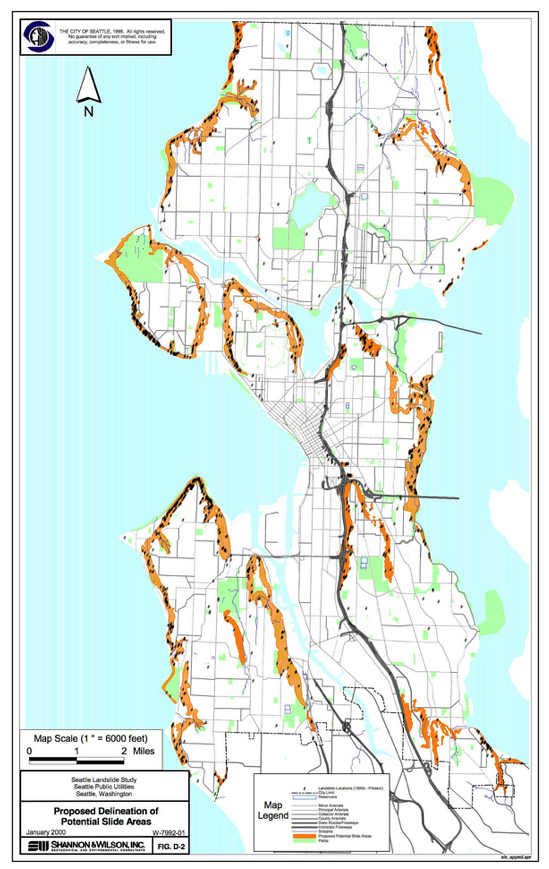The Oso landslide is a true tragedy, in part because as news reports have noted, study after study showed the dangers of the slope. It was steep, undermined by the river, made of unconsolidated sediments, and further weakened from above by clear cutting, which allowed water to permeate more easily into the hillside. We can only hope that this horrible event will encourage developers, home owners, and government officials to reconsider where they build and to establish more thorough regulations.
As many others have written, landslides are wide spread in this region, including Seattle. This is a fact that has long been known. Consider the letter written on February 27, 1897, by Seattle’s City Engineer Reginald Thomson to Corporation Counsel John K. Brown, the lead attorney for the city. Thomson wrote that landslides had occurred in Seattle “from a time to which the memory of man runneth not back.” The reason had to do with the intraction between a layer of impervious blue clay that lay at the base of the land and pervious glacial drift atop it. When it rains, wrote Thompson, water percolates through the drift “in devious ways” until it reaches the clay below, resulting in a “condition of saturation and suspension” that continues until “the surface ground breaks and settles down.”
Modern geologists refer to Thomson’s drift as the Esperance Sand, a layer deposited 17,400 years ago during the last ice age when a 3,000-foot-thick glacier passed over the region. The clay is known as the Lawton Clay, a rock unit deposited in advance of the sand. As Thomson noted, when it rains water penetrates the sand until it reaches the impermeable clay and in effect lubricates it and makes the slope susceptible to sliding.

Confirming Thomson’s observation, a recent study found that more than 1,400 landslides had hit Seattle since 1890. These included high bluff peeloffs, groundwater blowouts, deep-seated landslides, and skin slides. Skin slides, which are small and can be triggered by intense rainfall, are the most common. Deep-seated events are the most destructive; one of the best known in recent years was on Perkins Lane in Magnolia, when part of the bluff slid and carried several houses down to Puget Sound. The slide occurred in January, by far the worst month for sliding with almost three times more than the next nastiest months, February and March. Not coincidentally, November, December, and January receive the most precipitation.
(When owners of some of these houses sued the city, King County superior court judge Kathleen Learned ruled against them stating: “It is no small thing to re-engineer the basic geology of the region, which is what the Plaintiff’s position would lead to.”)
Usually fairly small and localized, landslides reveal the weak spots in the landscape, the places one might not want to build. This is one reason that green spaces such as Interlaken, Frink, Carkeek, and the Duwamish Greenbelt became parks and not home sites. But we have rewritten the story line, ignoring the historic reluctance to build on clearly less-than-stable slopes. More than 85 percent of the recorded slides owe their slippage to human created problems, include building improper drainage, not repairing broken pipes, chopping off the toes that protect slopes, and imprudent pruning of stabilizing vegetation. Many of the landslides that have hit since 1890 would probably have occurred in geologic time but with human activity we have fashioned a new time scale, one based on human time. In doing so we have made landslides more relevent to the city’s topography and to those who live here.
If you want to find evidence for slides and future slides, go to any steep hillside around the city. Look for areas mostly bare of shrubs or trees, such as the east side of Magnolia above the Magnolia bridge, which slid in 1997; areas rich in springs and seeps, evidence that water has percolated down to the Lawton Clay and is following gravity to the surface; areas covered in alders and maples, trees that pioneer unstable terrain; and areas with askew stairs that look as if they were made by a drunk contractor but which indicate ground movement. (Technically the hill is slumping and not sliding but it is still not a good sign. You can also see this in the tree. On a slumping slope, the trees either till backward or curve up at the bottom.)
Fortunately, the City of Seattle does recognize the high potential for landslides and has developed maps indicating particularly susceptible areas. But then such maps also existed for Oso. We need to do a better job at paying attention. The signs are there. Let’s hope we can learn from Oso.
